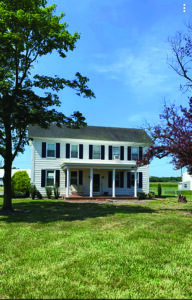(This article is part of a series that spotlights historic farmhouses in Caroline, Dorchester, Queen Anne’s, Kent and Talbot counties. These homes are being given new life by the younger generation that lives in them presently.)

(Photo courtesy Maddi Nagel)
In her novel The Book of Stillmeadow, author Gladys Taber captures the experience of living in an old house; “The ancient house speaks to us … echoing lives lived here long, long ago. And I think echoes of the lives of our family will be here, too.”
What a beautiful sentiment, and even more special is living in a home where those “echoing lives” were those of our ancestors.
J.T. Nagel and his wife Maddi live in such a house, situated on 110 acres of farmland on Laurel Grove Road outside Federalsburg.
The Nagel Family has a rich history rooted in Caroline County agriculture.
Heinrich “Henry” Nagel and his wife Louise immigrated to the United States from Germany in the 1880s and by 1890 had settled on what is now known as the Nagel Home Farm just outside Federalsburg.
Census records from 1900 list Henry Nagel’s occupation as “farmer.”
He and Louise would go on to have 10 children, many of whom would continue the family legacy of farming. Their son Christian inherited the farm, and then passed it on to his son, Myers. Myers and his wife Joanne raised three children in the house: Milton (J.T.’s father), Bea, and Margie. Myers passed away in 1999, and Joanne continued to live in her beloved home until she died in 2014.
The house was rented out for a few years before J.T. and Maddi moved there in 2018. Myers and Joanne had done some renovations in the 1970s and ’80s, such as removing fireplaces and installing baseboard heating.
However, the interior needed some cosmetic updates. J.T. and Maddi painted over the dark wood paneling, or “vertical shiplap” as J.T. jokingly called it, to brighten the spaces. They also replaced the old appliances with new ones.
The main part of the “Nagel Home Farm” house was originally a log cabin that was built before the Civil War.
Many generations and additions later, the house is now two stories and features five bedrooms, two bathrooms, a kitchen, a living room, office, and laundry room.
A chicken house that was built in the 1920s, now reinforced with tin siding, still stands 100 years later and now serves as a batting cage for the Colonel Richardson High School softball team.
Living in an old house is a lifestyle J.T. was born into, as his parents Milton and Tina raised him and his brother Lucas in a circa-1904 farmhouse across the road from the home farm.
Maddi laughed as she admitted she had a bit of a transition period after moving into the house since she grew up in a newer home in Kent Island.
One of the challenging features of the house is the low ceilings in the kitchen and dining room since they were the two rooms of the original log cabin.
“The ceilings are 6 feet high, which means there is limited counter space. There isn’t room for a Keurig to fit under the kitchen cabinets because the ceiling is so low,” Maddi explained.
Another unique, albeit challenging, feature of the home is the pump house.
Since the home was built before running water and plumbing were an option, the well pump and inlet pipe are housed in a small building next to the house.
J.T. described how he has to make sure he keeps a space heater going in the winter to ensure the house’s water supply does not freeze.
In modern homes, almost everything is built to standard measurements and can be quickly updated with a trip to a national chain hardware store.
In historic homes like the Nagels’, a simple task like replacing a door is not so simple.
“The doors were hand-made, so a replacement would have to be custom-made in order for it to fit,” Maddi added.
Despite the challenges, J.T. and Maddi love living in the house.
They both praise its stable, quality construction and marveled at how quiet the house is when storms are raging outside.
They look forward to future improvements, such as an addition on the front of the house, exposing and restoring the cooking fireplace, and raising the ceilings in the kitchen and dining room.
In Maddi’s words, they want to “modernize but still keep the original roots” of the house.
When asked where they would be living if they had not moved into the home farm house, J.T. struggled to come up with an answer.
“My dream was to always move here,” he shared with heartfelt sentimentality.
Through J.T. and Maddi, the echoes of Henry and Louise Nagel’s American Dream will continue for posterity.




